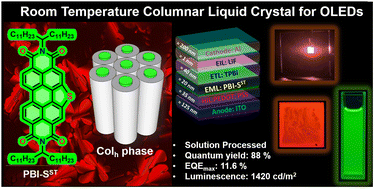Highly fluorescent room temperature liquid crystalline S-annulated swallow tail perylene bisimide exhibiting enhanced electroluminescence (EQE > 11%)†
Abstract
The demand for synthesizing highly luminescent compounds has emerged as a pivotal necessity in order to facilitate cost-effective and metal-free production of organic light-emitting diodes (OLEDs) on a commercial scale. This investigation introduces a readily soluble, electron deficient S-annulated perylene bisimide (PBI-SST) bearing swallow tails, exhibiting a room temperature columnar hexagonal mesophase with a low clearing point, and high photoluminescence quantum yield, thus making it a promising candidate for efficient OLEDs. Leveraging the luminescent properties of PBI-SST, a series of OLED devices were fabricated. PBI-SST was employed as the sole emitter and also incorporated at concentrations of 0.2, 0.5, and 1 wt% in CBP as the host material. Impressively, doped devices employing the compound at 0.2 wt% concentration within the host material CBP displayed an exceptional external quantum efficiency (EQE) of 6.5%. A maximum EQE of 11.6% was observed with 0.5 wt% PBI-SST in CBP, accompanied by a luminance of 1420 cd m−2. This notable increase in EQE can be ascribed to energy transfer between the host and guest materials, as well as a hybridized local charge transfer (HLCT) process. The substantial enhancement in EQE marks a significant advancement in the application of multifunctional columnar self-assembled materials for OLED development.



 Please wait while we load your content...
Please wait while we load your content...